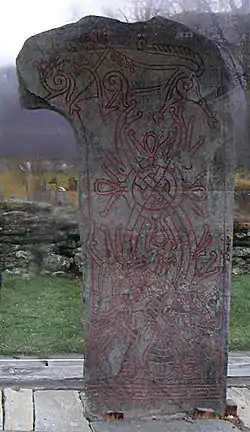| Vang stone | |
|---|---|
 | |
| Created | eleventh century |
| Discovered | Vang, Oppland, Norway |
| Rundata ID | N 84 |
| Runemaster | Gása |
| Text – Native | |
| Old Norse : Gása synir reistu stein þenna eptir Gunnar, bróðurson. | |
| Translation | |
| Gasi's sons raised this stone in memory of Gunnarr, (their) nephew. | |
Vang stone (Vangsteinen) listed as N 84 in Rundata is a runestone from the early eleventh century located at Vang in Oppland, Norway.[1] [2]
Description
The Vang stone was erected around 1000, during the transitional period from Paganism to Christianity in Norway. It was originally located in the traditional district of Valdres. It was situated outside a stave church at Vang. Vang Stave Church was dismantled and moved to Krummhübel, Germany in 1844. At that time, the runestone was moved to its current location, outside the Vang Church (Vang kirke).[3][4]
The stone is made of an irregular slab of slate. It is 2.15m tall, up to 1.25m wide and 8–13 cm thick. The artwork on the front of the stone is in Ringerike style, and depicts ribbons, leaves and a stylized animal, allegedly a lion.[5] Although thought to be a part of a stone portal, this idea is generally not supported. In contrast to other Viking Era runestones. The runic text is not integrated with the artwork to make a unified composition, but is carved along the edge of the stone.[5]
Inscription
A transliteration of the runic inscription into Latin characters is:
- kosa : sunir : ristu : s(t)in : þinsi : af(t)ir : kunar : bruþur:sun[6]
Translations:
- Norsk: "Gåsesønene reiste denne stein etter Gunnar, brorson sin."[7]
- English: "The Goose-sons raised this stone in memory of Gunnar, their nephew."[8]
References
- ↑ Vangsteinen (Olavsrosa)
- ↑ "Vangsteinen". Norsk kulturarv. Retrieved November 1, 2017.
- ↑ Vang kirke (Valdres) (Norske Kirkebygg)
- ↑ "Vangsteinen: Einer der schönsten Runensteine Skandinaviens". Norwegen Service. Retrieved November 1, 2017.
- 1 2 Spurkland, Terje (2005). Norwegian Runes and Runic Inscriptions. van der Hoek, Betsy (trans.). Boydell Press. pp. 91–93. ISBN 1-84383-186-4.
- ↑ Project Samnordisk Runtextdatabas Svensk – Rundata.
- ↑ Norsk Kulturarv – Vangsteinen.
- ↑ Norsk Culture Archive (EN) – Vang Stone.